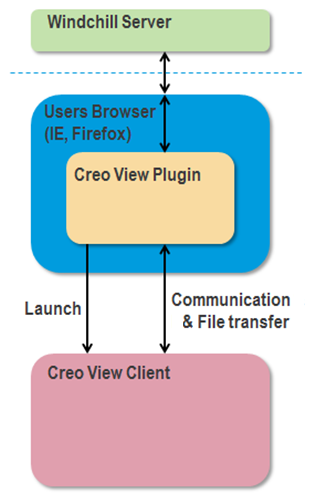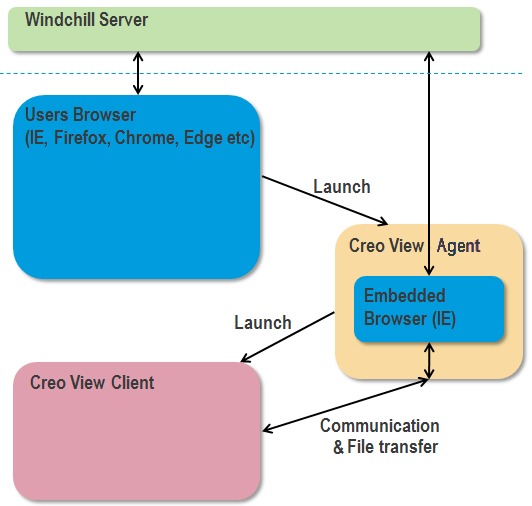Launching Creo View from Windchill
Overview
The Creo View client can be launched using the Open in Creo View action in a number of locations throughout Windchill from desktop computers with Creo View installed. When starting the Creo View client from Windchill, the client communicates with Windchill to retrieve data to be displayed to the user. Previously Windchill is configured to launch Creo View using a browser plug-in.
Web browsers are moving away from plug-in support. Google Chrome, Firefox and Microsoft Edge no longer support plug-ins. See CS 222882 for more information.
A new mechanism is therefore provided to initiate the Open in Creo View action from Windchill without using a browser plug-in. The new mechanism launches Creo View from a new executable independently of the browser that the user operates. By default, Windchill is configured to use the Creo View Agent to open Creo View, but the Administrator can switch to the plug-in mechanism by changing the Windchill setting described in “Browser Configurations” below.
This change does not affect opening embedded Creo View instances, such as thumbnails on the Visualization Panel, and in Thumbnail Navigation. For the same reason, a new mechanism, WebGL, is provided to support the Thumbnail Navigator. For more information about viewing thumbnail images using WebGL, go to Using WebGL to Render 3D Graphics at the end of this chapter.
About Launching Creo View Using a Plug-in (Legacy)
Launching the Creo View client in the browser requires a plug-in. This enables the Creo View client to be embedded in the browser. The plug-in utilizes the browser’s plug-in API’s to communicate with Windchill. When Creo View requests a file to be retrieved from Windchill, the browser makes the request on the client’s behalf. Since the browser is already authenticated with Windchill and the browser sends the request to Windchill on the behalf of the client, no separate authentication is needed. The following illustration articulates the communication between Windchill, the user’s browser, the Creo View plug-in, and the Creo View client.

Figure 1: The old launching mechanism
About Launching Creo View without a Plug-in
The user’s browser launches a new process, the Creo View Agent. The Creo View Agent operates as a separate executable outside of the user’s browser. Internet Explorer is embedded inside the Creo View Agent. This embedded browser is used for authentication and to communicate with Windchill. Creo View Agent launches the Creo View client and manages the communication with Windchill.

Figure 2: The new launching mechanism
Creo View Agent functions according to the following sequence:
1. Creo View Agent is started by your browser on each request to launch Creo View.
◦ A custom URI protocol, creoview://, is associated in the Windows registry with the executable pvagent.exe by the Creo View installer.
◦ The browser launches the associated executable providing the URL as a command line argument.
◦ The launch URL includes the Windchill base URL, the Windchill user name, the Windchill Session Context ID, and any options needed. The information is passed as a Base64 encoded JSON string.
2. Creo View Agent checks for other Creo View Agent processes that are running.
◦ If there are other processes, and one is for this Windchill server/ Windchill user combination, the request is forwarded to that (already authenticated and open) Creo View Agent process, and the current Creo View Agent process exits.
◦ If there are no processes or no match of Windchill server/ Windchill user, then this Creo View Agent process handles the request.
3. When Creo View Agent is started for the first time, it uses the embedded browser (Internet Explorer) to contact the base Windchill URL, and allow authentication.
◦ It contains a browser authentication dialog for basic authentication.
◦ Forms based authentication shows a window with the embedded browser window in it.
◦ The user name used for the Creo View Agent authentication must be the same user name that is used in the browser session where the Open in Creo View action was initiated.
4. Creo View Agent launches Creo View as a standalone application. It is not embedded in a browser window.
◦ Multiple Creo View sessions can be open concurrently.
◦ The user can add data to a selected open Creo View session.
5. Creo View routes all http requests though the Creo View Agent, in a similar manner to the Creo View plug-in in the browser.
◦ Creo View Agent’s embedded browser session services the http requests.
◦ Consequently, all of Creo View ’s browser interaction is with Internet Explorer.
6. The Creo View Agent time-out process begins when the Creo View sessions are closed. If the Creo View Agent is still running, the user can open new Creo View sessions. Default time-out value is 5 minutes. See “Browser Configurations” below to change the time-out settings.
• In short, the same Creo View Agent is used for multiple requests if the requests are for the same Windchill server and the same Windchill user. • Requests to launch Creo View can come from any combination of Windchill supported browsers. Data from different browser sessions can now be combined into one Creo View session, as long as they are launched from the same Windchill server and the same Windchill user. |
To Launch Creo View from Windchill
When you perform the Open in Creo View action, your browser displays a warning message that the named application is about to be launched. Select or clear the check box about remembering your selection for this application, and select the browser’s confirmation button to launch the program.
• Creo View opens in a standalone window, and the data is loaded.
• If one or more Creo View sessions are already open, the Open in Creo View dialog box opens with a list of the open sessions.
◦ To open a new session, select Create a New Session.
◦ To add to an existing session, select that session from the list.
Browser Configurations
The Administrator can change the settings of the following two Windchill configurations.
• The time-out value is configured (in seconds) with a wvs.properties setting. The default setting is 300 seconds (5 minutes).
-<Property default="300" name="wvs.openincreoview.session.timeout"/>
If you set the property value to 0, the Creo View Agent exits when the last Creo View session is exited.
• By default, the new mechanism is used for launching Creo View. Firefox and Internet Explorer users can launch Creo View by means of the plug-in mechanism by changes to these settings.
<Property default=“false" name="wvs.openincreoview.use.plugin.ie"/>
<Property default=“false" name="wvs.openincreoview.use.plugin.firefox"/>
<Property default=“false" name="wvs.openincreoview.use.plugin.firefox"/>
For Google Chrome and other browsers always use the new mechanism.
Using WebGL to Render 3D Graphics
WebGL (Web Graphics Library) is a JavaScript API for rendering interactive 3D computer graphics and 2D graphics within any compatible web browser without the use of plug-ins. In Windchill 11 M020 and later, WebGL is the default 3D graphics viewer. The client system does not need to have Creo View installed to enable the Thumbnail Navigator.
The thumbnail Copy Image action is not supported by WebGL. To enable Copy Image, the Administrator can launch the plug-in mechanism of Firefox and Internet Explorer by changing these settings:
<Property default=“false" name="wvs.thumbnailnav.use.plugin.ie"/>
<Property default=“false" name="wvs.thumbnailnav.use.plugin.firefox"/>
<Property default=“false" name="wvs.thumbnailnav.use.plugin.firefox"/>